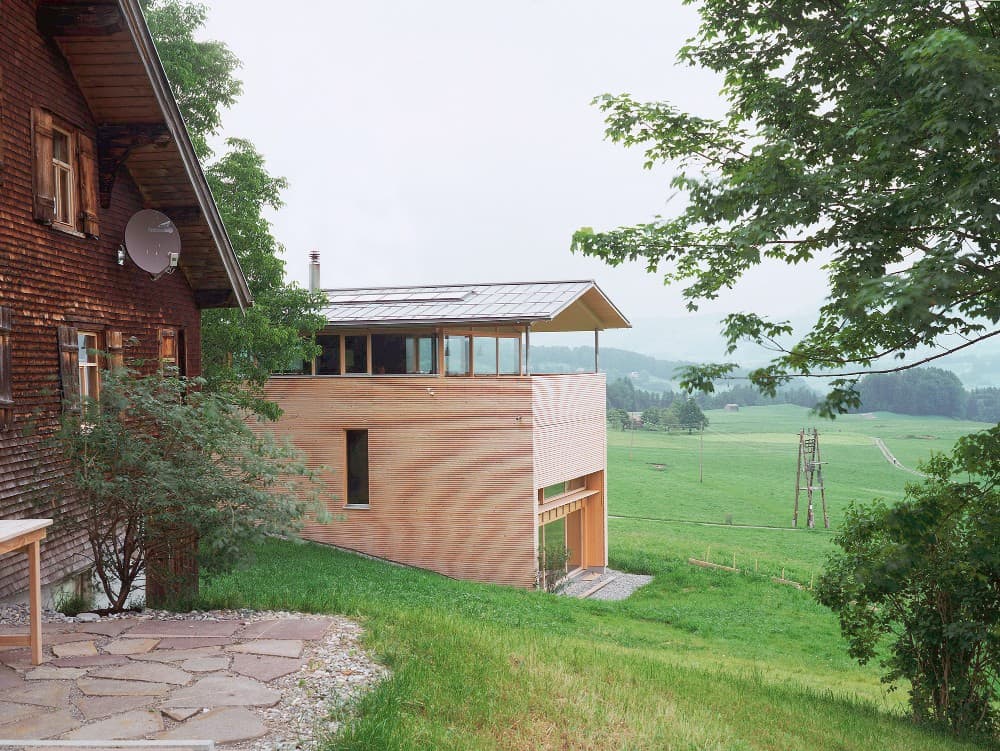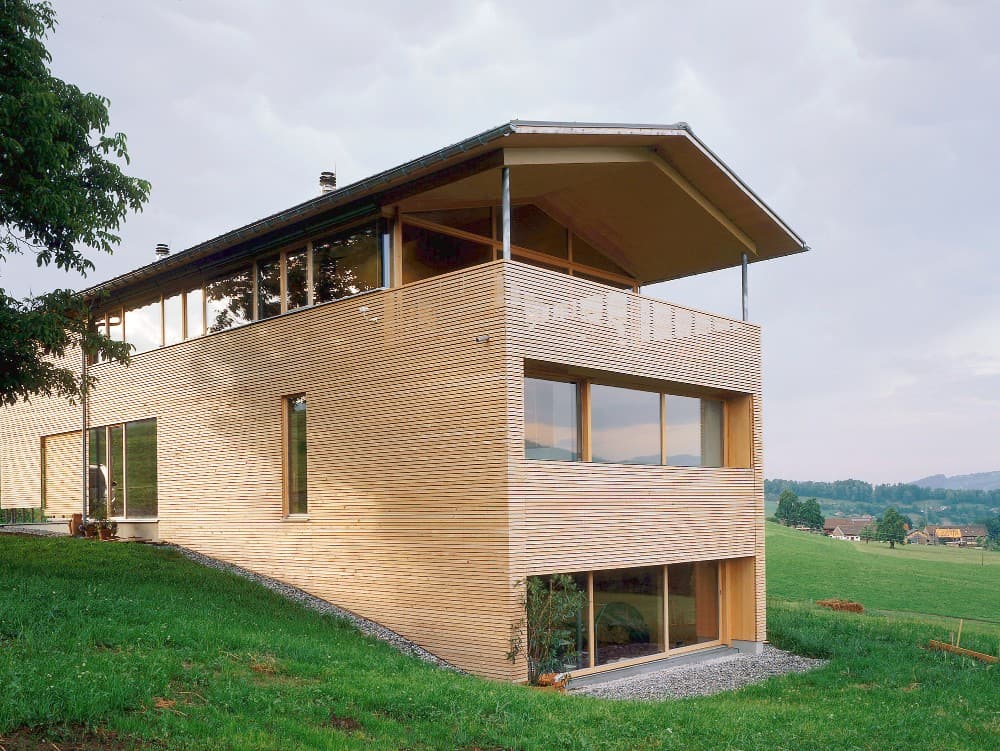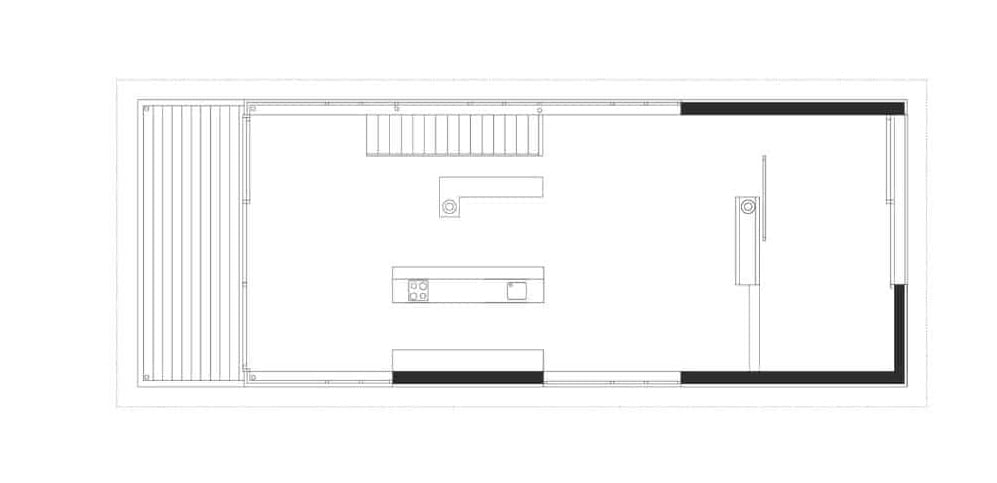
Client: private
Location: A-6867 Schwarzenberg
Architecture: Dietrich | Untertrifaller
Project management: Marina Hämmerle
Construction: 1999
Area: 268 m²
Planning
Statics: Mader & Flatz, Bregenz
Electrics: Meusburger, Bezau
Execution
Builder: Moosbrugger, Andelsbuch
Timber construction, facade: Fetz, Egg
Glass construction: Kothgassner, Dornbirn
Carpenter: Flatz, Egg; Schmiedinger, Schwarzenberg
Sanitary: Steurer, Schwarzenberg
Electrics: Vögel, Mellau
Photos: © Ignacio Martinez
As an unstructured barn-like solitaire, the house sits autonomously upon the mountain meadow. Typologically, the location and relationship to the landscape correspond to those scattered huts on the alpine pasture. The area used for agriculture and the house wall collide directly with each other. Neither a front garden nor fence nor adjoining buildings put the clear setting into perspective.
Understanding the Site
Our clients and we as architects took a prudent attitude and have shown understanding of the site and the handling of tradition. The common goal was to reinterpret the traditional Bregenzer Wälderhaus and to relate the house to its immediate surroundings – the hillside location with wide panoramic views, the embedding of the huge old walnut tree, the dialogue with the adjacent old farmhouse, which respects and courts the new building at the same time, while assuming its own identity.
Organization on three Levels
Like a barn, the house burrows into the gentle slope of the hillside, creating a half-length basement level housing a music room, a study, and service rooms below the main ground floor. Bedrooms are located on the ground floor, while a large, loft-like, and mostly open plan living, kitchen, and dining area has been created right at the top of the house. Turning the traditional house layout upside down and placing the main living spaces at the top of the house reinforces the connection with the landscape, in the sense that this level is the perfect viewing platform for appreciating the surrounding.
Design with Wood and Glass
Our design considers the privileged landscape location with a living floor glazed on three sides. The generous, high-vaulted room, completely clad in silver fir, is divided only by half-high elements such as the large kitchen island, which delineates the dining area by the window.
A flat pitched saddle roof draws its protective shield far out to cover the terrace placed in front. In the rear part above the Schopf-like entrance, structural walls rise up to the roof, defining a more intimate residential zone with a sliding window wall to the northwest.
The ground floor with a covered entrance, three bedrooms and garage is more withdrawn. The balcony parapet in front of the bedroom is height-adjustable and can therefore also be used as a vertical shutter.
The façade is completely covered with an outermost layer of horizontally bolted trims made out of larch wood. Their modest dimensions, the close distance, and a flush finish at the edges make them appear as texture, not as a slatted frame. There are no indications of a load-bearing system or the underlying layers.
Inside, dark walnut floors contrast with white walls and light fir veneer. The walls and ceiling of the corridors and the living area are completely clad with wood.
Construction from prefabricated Wooden Elements
In the tradition of the Bregenzerwald and in the immediate vicinity of an old farmhouse, wooden construction was obvious. Only the basement, partially inserted into the slope, is made of concrete. The ground floor and upper floor are built as wooden frameworks, with three concrete slabs for bracing.
The tent-like roof spans the entire living space (clear span 6.45 m) without supports or tension straps. The prefabricated, thermally insulated wooden elements, matched to the construction grid of ninety centimeters, are reinforced at the sides with UNP profiles and welded together on site. The external walls were delivered in elements and planked on both sides with an oriented strand board (OSB). The ceiling above the ground floor is made of prefabricated board stack elements, assembled on site. The installation time for the shell took three days.
Ecology
The construction method, the materials, and the heating system are testimony to the client’s ecological approach. The timber construction is clad with silver fir both on the in and outside.
In accordance with the client’s wish to create a house without conventional radiators with low energy consumption, we chose a hypocaust system. A duct system in the floor and wall directs the waste heat from the central wood stove in the basement to the upper floor, where it supplies a brick stove. The hot air circulates through a meandering system in the concrete slabs on the ground floor and is led into the next wall slab via floor channels. A solar service water system on the roof completes the environment-friendly approach.














